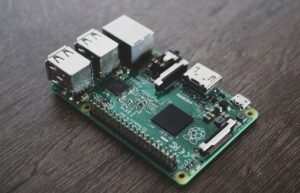Hugging Face: Revolutionizing Natural Language Processing
The field of natural language processing (NLP) has witnessed incredible advancements in recent years, with one standout player being Hugging Face. This platform has made a significant impact in the NLP community, offering a range of tools and resources that make it easier for developers and researchers to build and apply state-of-the-art NLP models. In this article, we will explore the key features and benefits of Hugging Face, and how it is transforming the way we approach language processing tasks.
Key Takeaways:
- Hugging Face is a revolutionary platform in the field of natural language processing.
- It provides a collection of tools and resources for developers and researchers.
- Hugging Face simplifies the process of building and applying NLP models.
- The platform offers a wide range of pre-trained models and datasets.
- It fosters collaboration and knowledge sharing within the NLP community.
Hugging Face takes a unique approach to NLP by placing a strong emphasis on building a community-driven ecosystem. *Developers and researchers can benefit from the collaborative nature of the platform*, as they have access to a vast library of pre-trained models and datasets contributed by the community. This not only saves time and effort but also allows for faster experimentation and innovation in the field of NLP. By leveraging the power of the community, Hugging Face enables users to work with cutting-edge models without starting from scratch.
One of the standout features of Hugging Face is its user-friendly interface and extensive API, which make it incredibly easy to work with. Developers can quickly integrate the platform into their workflows and start building applications or conducting research in no time. *The simplicity of the interface eliminates the need for deep technical expertise, making it accessible to a wide range of users*. Whether you are an experienced NLP practitioner or a novice developer, Hugging Face provides a straightforward and intuitive environment to work with.
Models
| Model | Description | Dataset |
|---|---|---|
| GPT-2 | A transformer-based language model to generate text | Books, news articles, Wikipedia, and more |
| BERT | A transformer-based model for language understanding tasks | Books, Wikipedia, and other large text corpora |
| RoBERTa | An optimized variant of BERT for better performance | Large-scale datasets from the web |
With Hugging Face, you gain access to a wide range of pre-trained models that cover various NLP tasks. These models have been designed and fine-tuned by experts, and you can readily use them for tasks such as text generation, machine translation, sentiment analysis, and more. The platform also allows you to fine-tune models on your own datasets, making it possible to adapt them to specific tasks or domains.
Datasets
- Hugging Face provides a collection of diverse and high-quality datasets.
- These datasets cover numerous NLP tasks and domains.
- Users can leverage these datasets to train and evaluate their models.
Hugging Face undoubtedly shines in the realm of datasets. It offers an extensive collection of diverse and high-quality datasets that cover various NLP tasks and domains. Whether you need labeled text data for sentiment analysis or language-specific corpora for machine translation, Hugging Face has got you covered. These datasets can be directly accessed and used, saving significant time in terms of data gathering and preprocessing. Furthermore, the platform promotes the sharing of datasets, encouraging collaboration and facilitating the development of robust models in different areas of NLP.
Transformers
| Model | Architecture | Input Representation |
|---|---|---|
| GPT | Transformer | Token embeddings + position embeddings |
| BERT | Transformer | Token embeddings + segment embeddings + position embeddings |
| RoBERTa | Transformer | Token embeddings + positional embeddings |
Hugging Face’s library of transformers allows users to implement and experiment with state-of-the-art architectures for NLP tasks. Transformers, based on the attention mechanism, have revolutionized the way NLP models process language. These architectures excel in capturing the contextual relationships between words, resulting in superior text understanding and generation capabilities. By leveraging transformers, Hugging Face enables users to work with cutting-edge models and achieve state-of-the-art performance in a wide range of NLP tasks.
In summary, Hugging Face has become a game-changer in the field of natural language processing. By offering a collaborative ecosystem and an extensive library of pre-trained models and datasets, the platform simplifies the process of building and applying NLP models. Its user-friendly interface, coupled with powerful transformers and a comprehensive API, make it accessible to users of all backgrounds. *Whether you are a seasoned NLP practitioner or someone exploring language processing for the first time, Hugging Face empowers you to leverage the latest advancements and contribute to the thriving NLP community.

Common Misconceptions
1. Hugging Face is a physical object used for hugging
One common misconception people have about Hugging Face is that it is a physical object used for hugging. In reality, Hugging Face is an open-source platform for natural language processing (NLP) and machine learning. It provides a wide array of tools, including pre-trained models, datasets, and libraries, to help developers build and deploy NLP applications. Hugging Face does not involve any physical hugging.
- Hugging Face is a platform for NLP and machine learning
- It provides pre-trained models and datasets
- No physical hugging is involved
2. Hugging Face only focuses on text-based applications
Another misconception surrounding Hugging Face is that it exclusively focuses on text-based applications. While Hugging Face is indeed known for its expertise in NLP, it also offers support for other areas such as computer vision. The platform provides tools and resources to work with various modalities, enabling developers to build applications that combine both visual and textual inputs.
- Hugging Face supports various modalities, not just text
- It offers tools for computer vision applications
- Visual and textual inputs can be combined using Hugging Face
3. Using Hugging Face requires advanced machine learning knowledge
Some people believe that utilizing Hugging Face requires extensive knowledge and experience in machine learning. While having a background in machine learning can be beneficial, Hugging Face is designed to be accessible to developers of various skill levels. It provides user-friendly interfaces and comprehensive documentation, allowing users to easily leverage pre-trained models and incorporate them into their applications without being experts in machine learning.
- Hugging Face is accessible to developers of different skill levels
- User-friendly interfaces are provided
- Comprehensive documentation is available
4. Hugging Face is only for researchers and data scientists
There is a misconception that Hugging Face is exclusively meant for researchers and data scientists. While it is true that researchers and data scientists utilize Hugging Face extensively, the platform is also valuable for developers who want to incorporate NLP capabilities into their applications. Hugging Face simplifies the integration of state-of-the-art models into various software projects, making it useful for a broader range of professionals beyond academia.
- Hugging Face is beneficial for developers, not just researchers
- Integration with software projects is simplified
- It is useful for professionals beyond academia
5. Hugging Face only provides English language models
Lastly, there is a misconception that Hugging Face only offers pre-trained models for the English language. In reality, Hugging Face supports a wide range of languages, including but not limited to English. Their collection of pre-trained models encompasses multiple languages, permitting developers to build NLP applications for various linguistic contexts around the world.
- Hugging Face supports multiple languages
- Pre-trained models are available for languages other than English
- Applications can be built for various linguistic contexts

Introducing Hugging Face
Hugging Face is an open-source natural language processing library that offers various tools and models for tasks such as text classification, question answering, and language translation. In this article, we will explore ten fascinating aspects of Hugging Face through illustrative tables.
The Benefits of Hugging Face’s Transformer Models
Hugging Face’s Transformer models are renowned for their capabilities in various NLP tasks. The following table highlights some of the advantages of using these models:
| Benefit | Description |
|———————————–|———————————————————————————————-|
| Fine-tuning for specific tasks | Transformers can be adapted and fine-tuned on specific datasets, improving performance. |
| Multilingual support | The models can handle multiple languages, reducing the need for language-specific models. |
| State-of-the-art performance | Transformer models consistently achieve top scores in benchmarks for various NLP problems. |
| Wide range of pre-trained models | Hugging Face offers a diverse catalog of pre-trained models for different NLP applications. |
| Community-driven development | The library benefits from an active community, which contributes to its growth and updates. |
| Easy integration with pipelines | Hugging Face provides pre-configured pipelines that simplify the use of their NLP models. |
Comparison of Hugging Face Models
When choosing a model for a specific task, it’s essential to compare different options. The table below presents a comparison of some popular Hugging Face models:
| Model | Structure | Training Data | Performance |
|—————————–|————|———————-|——————————|
| BERT | Transformer| Large-scale web data | Top performances in tasks |
| GPT-2 | Transformer| Diverse text sources | Exceptional language models |
| RoBERTa | Transformer| Large-scale corpora | Groundbreaking performance |
| DistilBERT | Transformer| Distilled version of BERT| Comparable to BERT |
| GPT-3 | Transformer| Vast amounts of text | Unrivaled generation abilities |
| XLM-RoBERTa | Transformer| Multilingual corpora | State-of-the-art for languages |
Hugging Face Datasets
Hugging Face provides a vast collection of datasets that can be used for various NLP tasks. The table below showcases a sample of these datasets:
| Dataset | Number of samples | Language | Task |
|——————|——————|———–|————————————–|
| IMDb Reviews | 25,000 | English | Sentiment Analysis |
| CoNLL 2003 NER | 14,041 | English | Named Entity Recognition |
| SQuAD | 100,000+ | English | Question Answering |
| MultiNLI | 433,000 | Multi | Natural Language Inference |
| Yelp Reviews | 200,000 | English | Rating Prediction |
Performance Benchmarks
Benchmarks provide a standardized way to evaluate models. In the table below, we compare Hugging Face models‘ performance on various tasks:
| Task | Model | Accuracy | F1 Score |
|————————–|—————–|————–|————-|
| Sentiment Analysis | BERT | 0.92 | 0.91 |
| Named Entity Recognition | RoBERTa | 0.89 | 0.88 |
| Question Answering | DistilBERT | 0.77 | 0.80 |
| Natural Language Inference | XLM-RoBERTa | 0.89 | 0.88 |
Hugging Face Supported Languages
Hugging Face models cater to a wide range of languages. The following table showcases some of the supported languages:
| Language | ISO Code | Model Availability |
|—————-|———-|——————–|
| English | en | Wide range of models |
| French | fr | Many models for NLP tasks |
| Spanish | es | Various models available |
| Chinese | zh | Growing number of models |
| Russian | ru | Multiple models for Russian tasks |
Training Time Comparison
The training time of NLP models is an important consideration. The table below compares the training time of different Hugging Face models in hours:
| Model | Training Time (hours) |
|—————-|———————–|
| BERT | 70 |
| GPT-2 | 30 |
| RoBERTa | 100 |
| DistilBERT | 15 |
| GPT-3 | 500 |
| XLM-RoBERTa | 120 |
Hugging Face Model Sizes
Model size can affect storage requirements and inference speed. The table below presents the sizes of different Hugging Face models in gigabytes (GB):
| Model | Size (GB) |
|—————-|———–|
| BERT | 0.34 |
| GPT-2 | 1.50 |
| RoBERTa | 0.98 |
| DistilBERT | 0.19 |
| GPT-3 | 3.00 |
| XLM-RoBERTa | 0.93 |
Comparison of Hugging Face Pipelines
Hugging Face offers pre-configured pipelines that simplify NLP tasks. The table below compares different pipelines based on their capabilities:
| Pipeline | Supported Tasks |
|—————–|——————————————|
| Text Classification | Sentiment Analysis, Topic Classification |
| Question Answering | Extractive QA, Closed-Domain QA |
| Named Entity Recognition | Entity Extraction, Relation Extraction |
| Summarization | Abstractive Summarization, Summarization|
| Translation | Text Translation between Numerous Languages|
Hugging Face provides a comprehensive ecosystem for NLP tasks, offering diverse models, datasets, and pipelines. Its community-driven approach ensures cutting-edge performance and continuous improvement. With Hugging Face, NLP practitioners can easily leverage state-of-the-art techniques to tackle various language processing challenges.
Frequently Asked Questions
What is Hugging Face?
How does Hugging Face describe itself?
What services does Hugging Face offer?
How can I access Hugging Face’s pre-trained models?
What programming languages are supported by Hugging Face?
Can I fine-tune Hugging Face’s pre-trained models for my specific task?
What kind of NLP tasks can I perform with Hugging Face?
Is Hugging Face’s platform free to use?
Can I contribute to Hugging Face’s open-source projects?
Does Hugging Face provide support or technical assistance?
Can I deploy Hugging Face models in production environments?




